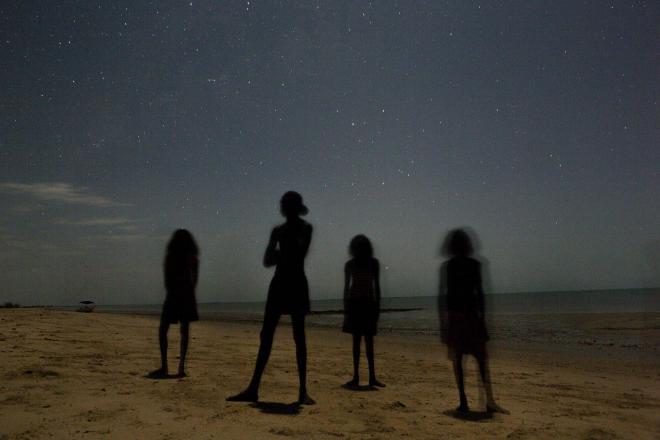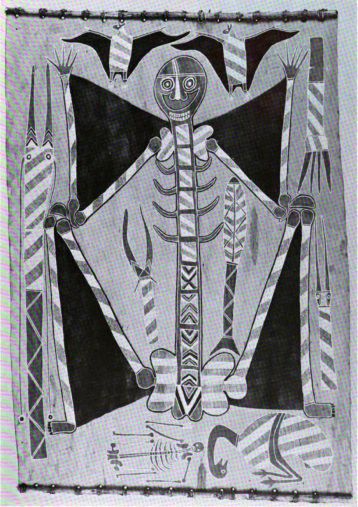Tens of thousands of years ago in Australia, the ancient ways of life were taught to humans in the Dreaming. Snakes wriggled up from underground and shaped the earth, and ancestral spirits came down from the sky or across the sea. These ancestors established the customs that would forever bind their descendants to them and govern their relationship with the world around them. One of these ancestors was a giant whale named Lumaluma who came to the Gunwinggu people of Arnhem Land in the guise of a ferocious giant. Swimming across from Indonesia, he landed at Cape Stewart, where the Gunwinggu greeted him with trepidation.

Aboriginal children at Cape Stewart, where the giant whale Lumaluma landed © Amy Toensing, National Geographic
Lumaluma caused havoc when he took on human shape and ate all of the Gunwinggus’ food. His hunger was so ravenous that he began to eat human beings, and that’s when the Gunwinggu banded together to attack him and his wives. An angry mob fatally wounded him, but he was so large that he did not die immediately. Instead, he took the opportunity to pass on important traditions to the Gunwinggu. Lumaluma educated them about the dances and sacred maraii objects to use in their rituals. He also modelled the designs that the Gunwinggu should cut into their flesh and paint on their bodies with red ochre to represent their homeland. These criss-crossed patterns also appear in the bark paintings he taught them to make. When Lumaluma had passed on everything the Gunwinggu needed to know, he finally died, and they tied his body against a tree. His spirit returned to the ocean in the shape of a whale, content that he had transmitted all of the knowledge the Gunwinggu would need to maintain their world.

Bark painting of Lumaluma by Bardulugubu © University of Western Australia
The art of bark painting that Lumaluma transmitted during the Dreaming still thrives in Arnhem Land in spite of the violent cultural disintegration Aboriginal groups have endured at the hands of European invaders. Today, Arnhem Land is one of the strongholds of Aboriginal culture. In their conception of the world, time is not a barrier to relationships with ancestors like Lumaluma. The arts and rituals that were passed down in the Dreaming make the ancestors accessible and articulate the people’s connection to all life around them. Bark paintings carry deep spiritual significance for those who create them, making them truly devotional works, just as they were when Lumaluma bestowed the art form upon the Gunwinggu. The painting to the left was done on a sheet of stringybark, which comes from eucalyptus trees. It shows Lumaluma surrounded by ritual objects, flying foxes, an emu, and the skeleton of one of his victims. Although this depiction of Lumaluma shows him in his human giant form rather than his whale form, the Gunwinggu and other coastal aboriginal groups demonstrated their reverence for whales in other bark paintings, like those below.


While the Aboriginal people of Australia did not actively hunt whales, some groups had strong ties of spiritual kinship to them, and they made use of beached whales for meat and tools. In future posts I hope to explore more examples of the relationship between cetaceans, Aboriginal Australians, and the Dreaming. But for now, we can marvel at the destructive appetite and deep wisdom attributed to one particular whale – Lumaluma the giant, whose legacy is reflected in every bark painting the Gunwinggu create.

Thank you for the lovely essay on the Dreamtime and on Gunwinggu — fascinating!
LikeLiked by 1 person
Wow, this is amazing!! And written so engagingly, the stories and the art all come alive!! I really love the relationship between the art and the stories, and the discussion of time! Great photos!
LikeLiked by 1 person